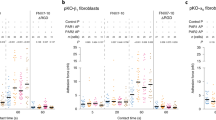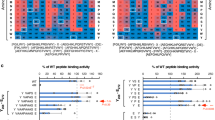Abstract
At sites of inflammation, ligation of leukocyte integrins is critical for the activation of cellular effector functions required for host defense. However, the signaling pathways linking integrin ligation to cellular responses are poorly understood. Here we show that integrin signaling in neutrophils and macrophages requires adaptors containing immunoreceptor tyrosine-based activation motifs (ITAMs). Neutrophils and macrophages lacking two ITAM-containing adaptor proteins, DAP12 and FcRγ, were defective in integrin-mediated responses. Activation of the tyrosine kinase Syk by integrins required that DAP12 and FcRγ were first phosphorylated by Src family kinases. Retroviral transduction of neutrophils and macrophages with wild-type and mutant Syk or DAP12 demonstrated that the Src homology 2 domains of Syk and the ITAM of DAP12 were required for integrin signaling. Our data show that integrin signaling for the activation of cellular responses in neutrophils and macrophages proceeds by an immunoreceptor-like mechanism.
This is a preview of subscription content, access via your institution
Access options
Subscribe to this journal
Receive 12 print issues and online access
$209.00 per year
only $17.42 per issue
Buy this article
- Purchase on Springer Link
- Instant access to full article PDF
Prices may be subject to local taxes which are calculated during checkout








Similar content being viewed by others
References
Berton, G. & Lowell, C.A. Integrin signalling in neutrophils and macrophages. Cell. Signal. 11, 621–635 (1999).
Bunting, M., Harris, E.S., McIntyre, T.M., Prescott, S.M. & Zimmerman, G.A. Leukocyte adhesion deficiency syndromes: adhesion and tethering defects involving β2 integrins and selectin ligands. Curr. Opin. Hematol. 9, 30–35 (2002).
Rosenzweig, S.D. & Holland, S.M. Phagocyte immunodeficiencies and their infections. J. Allergy Clin. Immunol. 113, 620–626 (2004).
Scharffetter-Kochanek, K. et al. Spontaneous skin ulceration and defective T cell function in CD18 null mice. J. Exp. Med. 188, 119–131 (1998).
Thomas, R.M. et al. C-terminal SRC kinase controls acute inflammation and granulocyte adhesion. Immunity 20, 181–191 (2004).
Lowell, C.A., Fumagalli, L. & Berton, G. Deficiency of Src family kinases p59/61hck and p58c-fgr results in defective adhesion-dependent neutrophil functions. J. Cell Biol. 133, 895–910 (1996).
Suen, P.W. et al. Impaired integrin-mediated signal transduction, altered cytoskeletal structure and reduced motility in Hck/Fgr deficient macrophages. J. Cell Sci. 112, 4067–4078 (1999).
Meng, F. & Lowell, C.A. A β1 integrin signaling pathway involving Src-family kinases, Cbl and PI-3 kinase is required for macrophage spreading and migration. EMBO J. 17, 4391–4403 (1998).
Mócsai, A., Zhou, M., Meng, F., Tybulewicz, V.L. & Lowell, C.A. Syk is required for integrin signaling in neutrophils. Immunity 16, 547–558 (2002).
Vines, C.M. et al. Inhibition of β2 integrin receptor and Syk kinase signaling in monocytes by the Src family kinase Fgr. Immunity 15, 507–519 (2001).
Obergfell, A. et al. Coordinate interactions of Csk, Src, and Syk kinases with αIIbβ3 initiate integrin signaling to the cytoskeleton. J. Cell Biol. 157, 265–275 (2002).
Fodor, S., Jakus, Z. & Mócsai, A. ITAM-based signaling beyond the adaptive immune response. Immunol. Lett. 104, 29–37 (2006).
Gao, J., Zoller, K.E., Ginsberg, M.H., Brugge, J.S. & Shattil, S.J. Regulation of the pp72syk protein tyrosine kinase by platelet integrin αIIbβ3 . EMBO J. 16, 6414–6425 (1997).
Woodside, D.G. et al. Activation of Syk protein tyrosine kinase through interaction with integrin β cytoplasmic domains. Curr. Biol. 11, 1799–1804 (2001).
Woodside, D.G. et al. The N-terminal SH2 domains of Syk and ZAP-70 mediate phosphotyrosine-independent binding to integrin β cytoplasmic domains. J. Biol. Chem. 277, 39401–39408 (2002).
Nathan, C. et al. Cytokine-induced respiratory burst of human neutrophils: dependence on extracellular matrix proteins and CD11/CD18 integrins. J. Cell Biol. 109, 1341–1349 (1989).
Jakus, Z., Berton, G., Ligeti, E., Lowell, C.A. & Mócsai, A. Responses of neutrophils to anti-integrin antibodies depends on costimulation through low affinity FcγRs: full activation requires both integrin and nonintegrin signals. J. Immunol. 173, 2068–2077 (2004).
Mócsai, A., Ligeti, E., Lowell, C.A. & Berton, G. Adhesion-dependent degranulation of neutrophils requires the Src family kinases Fgr and Hck. J. Immunol. 162, 1120–1126 (1999).
Gakidis, M.A. et al. Vav GEFs are required for β2 integrin-dependent functions of neutrophils. J. Cell Biol. 166, 273–282 (2004).
Mócsai, A. et al. G-protein-coupled receptor signaling in Syk-deficient neutrophils and mast cells. Blood 101, 4155–4163 (2003).
Pereira, S., Zhou, M., Mócsai, A. & Lowell, C. Resting murine neutrophils express functional α4 integrins that signal through Src family kinases. J. Immunol. 166, 4115–4123 (2001).
Mócsai, A. et al. The immunomodulatory adapter proteins DAP12 and Fc receptor γ-chain (FcRγ) regulate development of functional osteoclasts through the Syk tyrosine kinase. Proc. Natl. Acad. Sci. USA 101, 6158–6163 (2004).
Roach, T. et al. CD45 regulates Src family member kinase activity associated with macrophage integrin-mediated adhesion. Curr. Biol. 7, 408–417 (1997).
Turner, M. & Billadeau, D.D. Vav proteins as signal integrators for multi-subunit immune-recognition receptors. Nat. Rev. Immunol. 2, 476–486 (2002).
Koretzky, G.A., Abtahian, F. & Silverman, M.A. SLP76 and SLP65: complex regulation of signalling in lymphocytes and beyond. Nat. Rev. Immunol. 6, 67–78 (2006).
Newbrough, S.A. et al. SLP-76 regulates Fcγ receptor and integrin signaling in neutrophils. Immunity 19, 761–769 (2003).
Hall, A.B. et al. Requirements for Vav guanine nucleotide exchange factors and Rho GTPases in FcγR- and complement-mediated phagocytosis. Immunity 24, 305–316 (2006).
Faccio, R. et al. Vav3 regulates osteoclast function and bone mass. Nat. Med. 11, 284–290 (2005).
Obergfell, A. et al. The molecular adapter SLP-76 relays signals from platelet integrin αIIbβ3 to the actin cytoskeleton. J. Biol. Chem. 276, 5916–5923 (2001).
Zhou, M.J. & Brown, E.J. CR3 (Mac-1, αMβ2, CD11b/CD18) and FcγRIII cooperate in generation of a neutrophil respiratory burst: requirement for FcγRIII and tyrosine phosphorylation. J. Cell Biol. 125, 1407–1416 (1994).
Tarrant, J.M., Robb, L., van Spriel, A.B. & Wright, M.D. Tetraspanins: molecular organisers of the leukocyte surface. Trends Immunol. 24, 610–617 (2003).
Abtahian, F. et al. Mol. Cell. Biol. 26, 6936–6949 (2006).
Bakker, A.B. et al. DAP12-deficient mice fail to develop autoimmunity due to impaired antigen priming. Immunity 13, 345–353 (2000).
Takai, T., Li, M., Sylvestre, D., Clynes, R. & Ravetch, J.V. FcR γ chain deletion results in pleiotrophic effector cell defects. Cell 76, 519–529 (1994).
Turner, M. et al. Perinatal lethality and blocked B-cell development in mice lacking the tyrosine kinase Syk. Nature 378, 298–302 (1995).
Mócsai, A. et al. Differential effects of tyrosine kinase inhibitors and an inhibitor of the mitogen-activated protein kinase cascade on degranulation and superoxide production of human neutrophil granulocytes. Biochem. Pharmacol. 54, 781–789 (1997).
Nishiya, T. & DeFranco, A.L. Ligand-regulated chimeric receptor approach reveals distinctive subcellular localization and signaling properties of the Toll-like receptors. J. Biol. Chem. 279, 19008–19017 (2004).
Acknowledgements
We thank Y. Refaeli for the pMIG-W vector; K. Makara and Á. Mikesy for mouse colony management; M. Kovács for help with experiments; and A. Erdei for access to equipment. Syk+/− mice and anti-Syk were from V. Tybulewicz (National Institute for Medical Research); Itgb2−/− (CD18-knockout) mice were from A. Beaudet (Baylor College of Medicine); anti-DAP12 was from T. Takai (Tohoku University); and the GST-Syk-(SH2)2 fusion protein was from A. DeFranco (University of California, San Francisco). Supported by the US National Institutes of Health (TW006831 to C.A.L. and A.M.; AI065150 and AI065495 to C.A.L.; and AI068129 to L.L.L.), the Hungarian National Scientific Research Fund (T046409 to A. M.), the Wellcome Trust (A.M.), the European Molecular Biology Organization–Howard Hughes Medical Institute (A.M.), the Hungarian Academy of Sciences (Bolyai Research Fellowship to A.M.) and the American Cancer Society Research (L.L.L.).
Author information
Authors and Affiliations
Contributions
A.M. and C.A.L. initiated the study; A.M., C.L.A., Z.J. and C.A.L. designed and did the experiments; A.M. supervised the work in Budapest; Y.H. did fetal liver stem cell transfers and maintained mouse colonies; L.L.L. provided intellectual guidance and manuscript editing; and A.M., C.L.A. and C.A.L. wrote the manuscript.
Corresponding authors
Ethics declarations
Competing interests
The authors declare no competing financial interests.
Supplementary information
Supplementary Fig. 1
Normal integrin and Gr1 expression on neutrophils lacking DAP12 and FcRγ. (PDF 57 kb)
Supplementary Fig. 2
ITAM-like signaling in human neutrophils. (PDF 107 kb)
Supplementary Fig. 3
Lack of the FcRγ-chain associated kinase activity in Syk-KO neutrophils. (PDF 94 kb)
Supplementary Fig. 4
Model of integrin signaling in neutrophils and macrophages. (PDF 50 kb)
Supplementary Fig. 5
Normal expression of β2-integrins on macrophages lacking DAP12 and FcRγ. (PDF 46 kb)
Rights and permissions
About this article
Cite this article
Mócsai, A., Abram, C., Jakus, Z. et al. Integrin signaling in neutrophils and macrophages uses adaptors containing immunoreceptor tyrosine-based activation motifs. Nat Immunol 7, 1326–1333 (2006). https://doi.org/10.1038/ni1407
Received:
Accepted:
Published:
Issue Date:
DOI: https://doi.org/10.1038/ni1407
This article is cited by
-
New small molecules in dermatology: for the autoimmunity, inflammation and beyond
Inflammation Research (2023)
-
Neutrophil Activation and Immune Thrombosis Profiles Persist in Convalescent COVID-19
Journal of Clinical Immunology (2023)
-
Microglial TYROBP/DAP12 in Alzheimer’s disease: Transduction of physiological and pathological signals across TREM2
Molecular Neurodegeneration (2022)
-
Characterization of the mechanism of action of lanraplenib, a novel spleen tyrosine kinase inhibitor, in models of lupus nephritis
BMC Rheumatology (2021)
-
Spleen tyrosine kinase facilitates neutrophil activation and worsens long-term neurologic deficits after spinal cord injury
Journal of Neuroinflammation (2021)



